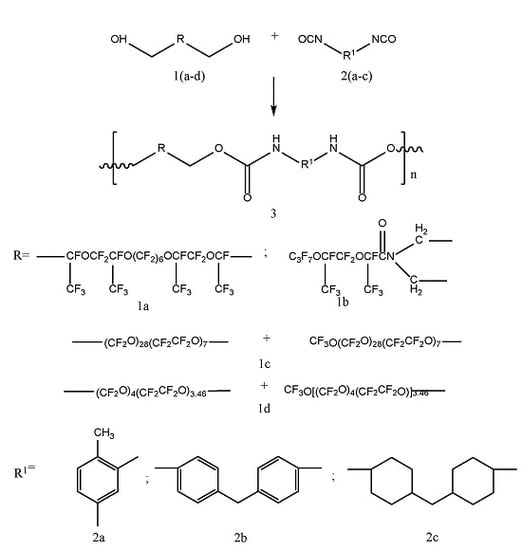Fluorinated Polyurethanes, Synthesis and Properties
Abstract
:1. Introduction
2. Results and Discussion
3. Materials and Methods
3.1. Synthesis of Fluorinated Alcohol 1b
3.2. Synthesis of Fluoropolyurethanes
3.2.1. Synthesis of Fluoropolyurethane 5
3.2.2. Synthesis of Fluoropolyurethane 7
4. Conclusions
Acknowledgments
Author Contributions
Conflicts of Interest
References
- Wang, X.; Hu, J.; Li, Y.; Zhang, J.; Ding, Y. The surface properties and corrosion resistance of fluorinated polyurethane coatings. J. Fluorine Chem. 2015, 176, 14–19. [Google Scholar] [CrossRef]
- Chattopadhyay, D.K.; Raju, K.V.S.N. Structural engineering of polyurethane coatings for high performance applications. Prog. Polym. Sci. 2007, 32, 352–418. [Google Scholar] [CrossRef]
- Yoon, S.C.; Ratner, B.D. Surface structure of segmented poly (ether urethanes) and poly (ether urethane ureas) with various perfluoro chain extenders. An X-ray photoelectron spectroscopic investigation. Macromolecules 1986, 19, 1068–1079. [Google Scholar] [CrossRef]
- Yoon, S.C.; Ratner, B.D. Surface and bulk structure of segmented poly (ether urethanes) with perfluoro chain extenders. 2. FTIR, DSC, and X-ray photoelectron spectroscopic studies. Macromolecules 1988, 21, 2392–2400. [Google Scholar] [CrossRef]
- Yoon, S.C.; Ratner, B.D. Surface and bulk structure of segmented poly (ether urethanes) with perfluoro chain extenders. 3. Effects of annealing, casting solvent, and casting conditions. Macromolecules 1988, 2, 2401–2404. [Google Scholar] [CrossRef]
- Yoon, S.C.; Sung, Y.K.; Ratner, B.D. Surface and bulk structure of segmented poly (ether urethanes) with perfluoro chain extenders. 4. Role of hydrogen bonding on thermal transitions. Macromolecules 1990, 2, 4351–4356. [Google Scholar] [CrossRef]
- Yoon, S.C.; Ratner, B.D.; Ivan, B.; Kennedy, J.P. Surface and bulk structure of segmented poly (ether urethanes) with perfluoro chain extenders. 5. Incorporation of poly(dimethylsiloxane) and polyisobutylene macroglycols. Macromolecules 1994, 27, 1548–1554. [Google Scholar] [CrossRef]
- Eberhard, K.; Beate, B.; Christian, F.; Juan, G.B. Fluorine-Containing Blocked Isocyanates. US Patent 6509433, 21 January 2003. [Google Scholar]
- Ho, T.; Wynne, K.J. A new fluorinated polyurethane: Polymerization, characterization, and mechanical properties. Macromolecules 1992, 25, 3521–3527. [Google Scholar] [CrossRef]
- Honeychuck, R.V.; Ho, T.; Wynne, K.J.; Nissan, R.A. Preparation and characterization of polyurethanes based on a series of fluorinated diols. Chem. Mater 1993, 5, 1299–1306. [Google Scholar] [CrossRef]
- Yu, X.H.; Okkema, A.Z.; Cooper, S.L. Synthesis and physical properties of poly(fluoroalkylether) urethanes. J. Appl. Polym. Sci. 1990, 41, 1777–1795. [Google Scholar] [CrossRef]
- Ge, Z.; Zhang, X.; Dai, J.; Li, W.; Luo, Y. Synthesis, characterization and properties of a novel fluorinated polyurethane. Eur. Polym. J. 2009, 45, 530–536. [Google Scholar] [CrossRef]
- Nobuo, T. Low Refractive Index Resin Composition and Cured Product Thereof. JP Patent 2007023175 (A), 1 February 2007. [Google Scholar]
- Bradly, M.; Oreffo, R.; Tare, R.; Tourniaire, Y. Selective Cellular Adhesion on Polymer Microarrays. GB 2425074 A, 18 October 2006. [Google Scholar]
- Chen, K.-Y.; Kuo, J.-F. Synthesis and properties of novel fluotinated aliphatic polyurethanes with fluoro chain extenders. Macromol. Chem. Phys. 2000, 201, 2676–2686. [Google Scholar] [CrossRef]
- Król, P.; Król, B.; Stagraczyński, R.; Skrzypiec, K. Waterborne cationomer polyurethane coatings with improved hydrophobicproperties. J. Appl. Polym. Sci. 2013, 10, 2508–2519. [Google Scholar] [CrossRef]
- Król, P.; Król, B. Surface free energy of polyurethane coatings with improves hydrophobicity. Colloid Polym. Sci. 2012, 290, 879–893. [Google Scholar] [CrossRef] [PubMed]
- Lin, Y.H.; Chou, N.K.; Chang, C.H.; Wang, S.S.; Chu, S.H.; Hsieh, K.H. Blood compatibility of fluorodiol-containing polyurethanes. J. Polym. Sci. Polym. Chem. 2007, 45, 3231–3242. [Google Scholar] [CrossRef]
- Mashinskaya, S.G.; Menshov, V.M.; Kiseleva, L.A.; Ponomarenko, V.A. Super-flexibility of some fluoropolymeric chains. Abstr. Pap. Am. Chem. Soc. 1995, 210, 171. [Google Scholar]
- Krukovsky, S.P.; Yarosh, A.A.; Glazkov, A.A. Synthesis of cross-linked perfluoroalkylene oxides. In Proceedings of the Advanced Technologies and Production of Organic and Inorganic Chemistry-95, Moscow, Russia, 25–28 April 1995.
- Dombrow, B.A. Chemistry. In Polyurethanes, 2nd ed.; Simonds, H.R., Ed.; Reinhold Publishing Corp: New York, NY, USA, 1965; pp. 12–33. [Google Scholar]
- Fergusson, J.; Petrovic, Z. Thermal stability of segmented polyurethanes. Eur. Polym. J. 1976, 12, 177–181. [Google Scholar] [CrossRef]
- Simon, J.; Barla, F.; Haller, A.K.; Farkas, F.; Kraxner, M. Thermal stability of polyurethanes. Chromatographia 1988, 25, 99–106. [Google Scholar]
- Ushakova, E.N.; Konyushko, O.V.; Glazkov, A.A.; Krukovsky, S.P. Synthesis of 1,1-dihydroperfluorooxaalkan-1-ols and their interaction with terephtaloyl chloride. Russ. Chem. Bull. 1996, 45, 1573–1576. [Google Scholar] [CrossRef]
- Zhao, Z.; Li, X.; Li, P.; Wang, C.; Luo, Q. Study on properties of waterborne fluorinated polyurethane/acrylate hybrid emulsion and films. J. Polym. Res. 2014, 21, 460. [Google Scholar] [CrossRef]
- Ananikov, V.P.; Galkin, K.I.; Egorov, M.P.; Sakharov, A.M.; Zlotin, S.G.; Redina, E.A.; Isaeva, V.I.; Kustov, L.M.; Gening, M.L.; Nifantiev, N.E. Challenges in the Development of Organic and Hybrid Molecular Systems. Mendeleev Commun. 2016, 26. [Google Scholar] [CrossRef]
- Sample Availability: Samples of the compounds 3 are available from the authors.




| No. | Initial Mixture Composition | Reaction Conditions | Polymer′s Appearance | Contact Angle by Water (°) | Parameters of the Polymers |
|---|---|---|---|---|---|
| 1 | 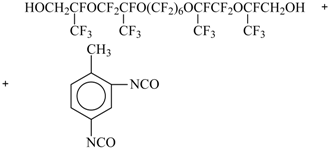 | 60 °C–150 °C 17 h in nitrogen flow DMFA | Solid elastic light-brown | 101 | (η) = 0.006 dL/g in DMFA |
| 2 | 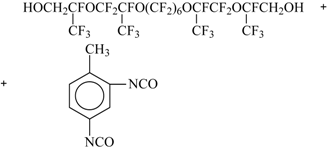 | 190 °C 17 h in nitrogen flow, in melt | Solid elastic light-brown | 101 | Mp = 20 °C; (ƞ) = 0.01 dL/g in DMFA T5% decomp. = 261 °C |
| 3 | 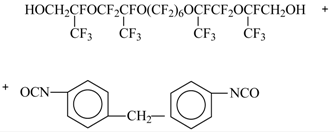 | 190 °C 15 h in nitrogen flow, in melt | Solid yellowish brown | 110 | T5% decomp. = 323 °C |
| 4 | 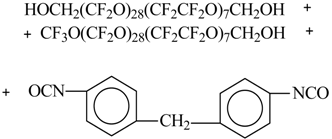 | 190 °C 9 h in nitrogen flow, in melt | Colorless transparent | 113 | T5% decomp. = 247 °C Tg = −143.6 °C (η) = 0.13 dL/g in C6F6 |
| 5 | 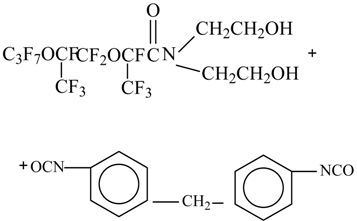 | Room temp., at stirring, in nitrogen flow 1.05:1 DMFA | Brittle yellowish mass | 111 | Mp = 95−98 °C T5% decomp. = 247 °C МW = 9667 Мn = 6062 D = 1.59–1.60 |
| 6 | 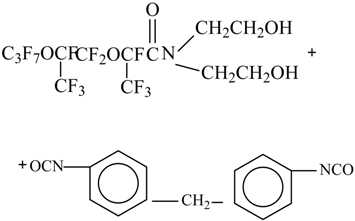 | Room temp., at stirring, in nitrogen flow, 1:1.1 DMFA | Brittle yellowish-brown mass | 114 | Mp = 94–96 °C |
| 7 |  | until 190 °C in nitrogen flow 50 h, 1:1, in melt | Homogenous thick colorless transparent mass | 102 | (η) = 0.14 dL/g Tg = −139 °C Mp = − 22 °C (contains cryst.polym. segments) T5% decomp. = 300 °C |
| 8 |  | until 190 °C in nitrogen flow 16 h, 1:1, in melt | Homogenous elastic opalescent mass | 104 | (η) = 0.103 dL/g Tg = −132 °C Mp = −12 °C (contains cryst. polym. segments) T5% decomp. = 290 °C |
| 9 | 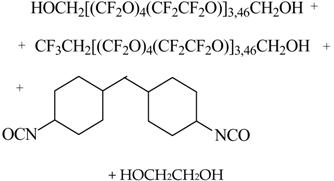 | 60 °C in nitrogen flow, at stirring 10 h 1:3:2 C6F6 | Homogenous white viscous elastic mass | 103 | Tg = −132 °C |
| 10 | 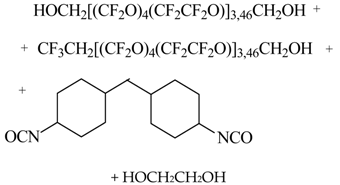 | 60 °C in nitrogen flow, at stirring 7 h 1:2:1 C6F6 | Homogenous white solid elastic mass | 106 | Tg = −136 °C |
| 11 | 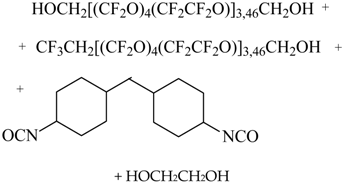 | 60 °C in nitrogen flow, at stirring 12 h 1:2:5 C6F6 | Homogenous white elastic mass | 117 | (η) = 0.14 dL/g Tg = −133 °C T5% decomp. = 244 °C |
| 12 |  | until 190 °C in nitrogen flow 7 h 1:2:5 in melt | Homogenous beige solid elastic mass | 106 | Tg = −137 °C T5% decomp. = 237 °C |
© 2016 by the authors. Licensee MDPI, Basel, Switzerland. This article is an open access article distributed under the terms and conditions of the Creative Commons Attribution (CC-BY) license ( http://creativecommons.org/licenses/by/4.0/).
Share and Cite
Smirnova, O.; Glazkov, A.; Yarosh, A.; Sakharov, A. Fluorinated Polyurethanes, Synthesis and Properties. Molecules 2016, 21, 904. https://doi.org/10.3390/molecules21070904
Smirnova O, Glazkov A, Yarosh A, Sakharov A. Fluorinated Polyurethanes, Synthesis and Properties. Molecules. 2016; 21(7):904. https://doi.org/10.3390/molecules21070904
Chicago/Turabian StyleSmirnova, Olga, Alexey Glazkov, Alexander Yarosh, and Alexey Sakharov. 2016. "Fluorinated Polyurethanes, Synthesis and Properties" Molecules 21, no. 7: 904. https://doi.org/10.3390/molecules21070904




